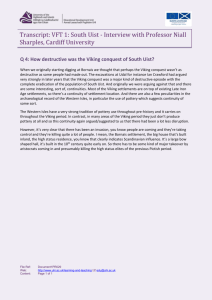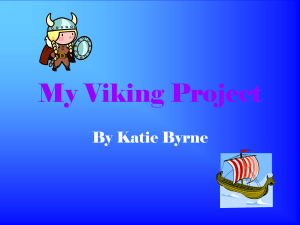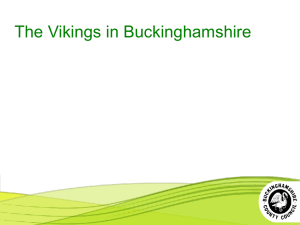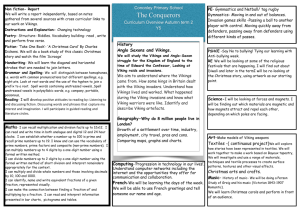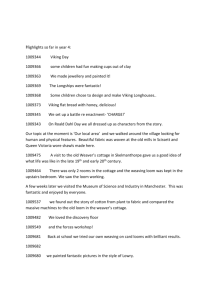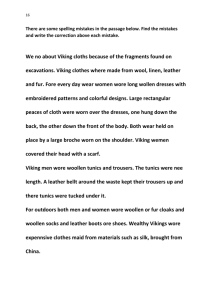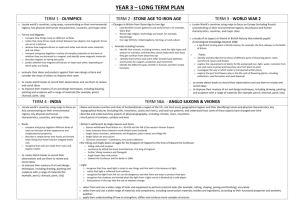Year 6 Long Term Planning - Allerton CE Primary School
advertisement
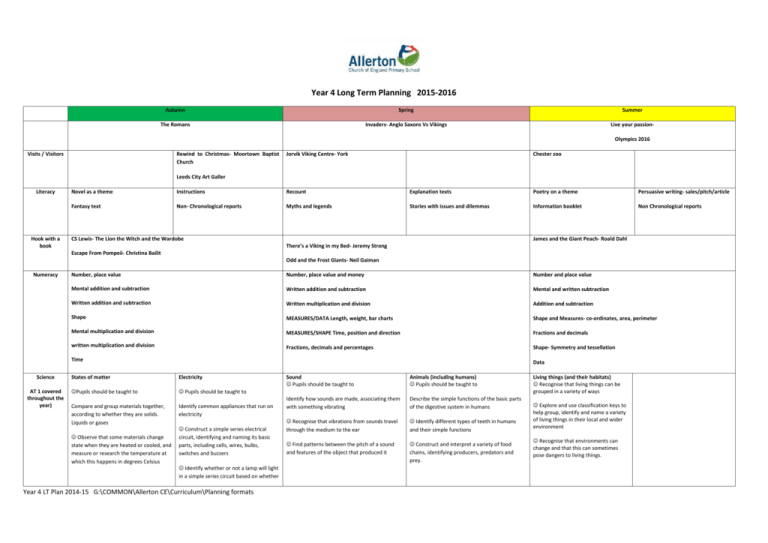
Year 4 Long Term Planning 2015-2016 Autumn Spring Summer The Romans Invaders- Anglo Saxons Vs Vikings Live your passionOlympics 2016 Visits / Visitors Rewind to Christmas- Moortown Baptist Church Jorvik Viking Centre- York Chester zoo Leeds City Art Galler Literacy Hook with a book Novel as a theme Instructions Recount Explanation texts Poetry on a theme Persuasive writing- sales/pitch/article Fantasy text Non- Chronological reports Myths and legends Stories with issues and dilemmas Information booklet Non Chronological reports CS Lewis- The Lion the Witch and the Wardobe James and the Giant Peach- Roald Dahl There’s a Viking in my Bed- Jeremy Strong Escape From Pompeii- Christina Bailit Odd and the Frost Giants- Neil Gaiman Numeracy Number, place value Number, place value and money Number and place value Mental addition and subtraction Written addition and subtraction Mental and written subtraction Written addition and subtraction Written multiplication and division Addition and subtraction Shape MEASURES/DATA Length, weight, bar charts Shape and Measures- co-ordinates, area, perimeter Mental multiplication and division MEASURES/SHAPE Time, position and direction Fractions and decimals written multiplication and division Fractions, decimals and percentages Shape- Symmetry and tessellation Time Science AT 1 covered throughout the year) Data States of matter Electricity Pupils should be taught to Pupils should be taught to Compare and group materials together, according to whether they are solids. Liquids or gases Identify common appliances that run on electricity Observe that some materials change state when they are heated or cooled, and measure or research the temperature at which this happens in degrees Celsius Construct a simple series electrical circuit, identifying and naming its basic parts, including cells, wires, bulbs, switches and buzzers Identify whether or not a lamp will light in a simple series circuit based on whether Year 4 LT Plan 2014-15 G:\COMMON\Allerton CE\Curriculum\Planning formats Sound Pupils should be taught to Animals (including humans) Pupils should be taught to Identify how sounds are made, associating them with something vibrating Describe the simple functions of the basic parts of the digestive system in humans Recognise that vibrations from sounds travel through the medium to the ear Identify different types of teeth in humans and their simple functions Find patterns between the pitch of a sound and features of the object that produced it Construct and interpret a variety of food chains, identifying producers, predators and prey. Living things (and their habitats) Recognise that living things can be grouped in a variety of ways Explore and use classification keys to help group, identify and name a variety of living things in their local and wider environment Recognise that environments can change and that this can sometimes pose dangers to living things. Identify the part played by evaporation and condensation in the water cycle and associate the rate of evaporation with temperature. or not the lamp is part of a complete loop with a battery Recognise that a switch opens and closes a circuit and associate this with whether or not a lamp lights in a simple series circuit Find patterns between the volume of a sound and the strength of the vibrations that produced it Recognise that sounds get fainter as the distance from the sound source increases. Recognise some common conductors and insulators, and associate metals with being good conductors RE History Following the Leeds agreed syllabus for RE The Roman Empire and its impact on Britain Britain’s settlement by Anglo-Saxons and Scots The Roman Empire by AD 42 and the power of its army invasions, settlements and kingdoms: place names and village life “Romanisation” of Britain: sites such as Deva and York and the impact of technology, culture and beliefs, including early Christianity Anglo-Saxon art and culture The Viking and Anglo-Saxon struggle for the Kingdom of England to the time of Edward the Confessor Viking raids and invasion Anglo-Saxon laws and justice A study of an aspect or theme in British History that extends pupils chronological knowledge beyond 1066 changes in an aspect of social history, such as crime and punishment from the Anglo-Saxons Geography Name and locate the world’s seven continents and five oceans (carried over from KS1) Human and Physical features of York and Leeds. Olympics 2016: Brazil Locate the world’s countries, using maps to focus on Europe (including the location of Russia) and North and South America, concentrating on their environmental regions, key physical and human characteristics, countries, and major cities describe and understand key aspects of: Use the eight points of a compass, four and six-figure grid references, symbols and key (including the use of Ordnance Survey maps) to build their knowledge of the United Kingdom and the wider world name and locate counties and cities of the United Kingdom, geographical regions and their identifying human and physical characteristics, key topographical features (including hills, mountains, coasts and rivers), and land-use patterns; and understand how some of these aspects have changed over time understand geographical similarities and differences through the study of human and physical geography of a region of the United Kingdom, a region in a European country, and a region within North or South America human geography, including: types of settlement and land use, economic activity including trade links, and the distribution of natural resources including energy, food, minerals and water Year 4 LT Plan 2014-15 G:\COMMON\Allerton CE\Curriculum\Planning formats physical geography, including: climate zones, biomes and vegetation belts, rivers, mountains, volcanoes and earthquakes, and the water cycle name and locate counties and cities of the United Kingdom, geographical regions and their identifying human and physical characteristics, key topographical features (including hills, mountains, coasts and rivers), and land-use patterns; and understand how some of these aspects have changed over time use fieldwork to observe, measure and record the human and physical features in the local area using a range of methods, including sketch maps, plans and graphs, and digital technologies. use maps, atlases, globes and digital/computer mapping to locate countries and describe features studied describe and understand key aspects of: physical geography, including: climate zones, biomes and vegetation belts, rivers, mountains, volcanoes and earthquakes, and the water cycle identify the position and significance of latitude, longitude, Equator, Northern Hemisphere, Southern Hemisphere, the Tropics of Cancer and Capricorn, Arctic and Antarctic Circle, Locate the world’s countries, using maps to focus on Europe (including the location of Russia) and North and South America, concentrating on their environmental regions, key physical and human characteristics, countries, and major cities Art Portraits: Collage: 3D/ Painting: Painting: Printing/ Drawing 3D/ textiles Paint/ pastels/ collage Roman Mosaics Viking shields-papier mache/ paint Longboat seascape using a range of different materials. Leaf printing Clay animals Picasso Technology Evaluating processes and products ongoing throughout the year Observational / still life drawings Food: Textiles: Food: Structures: Overlap from Previous term Making Roman soup Making a Viking purse Making Viking Bread Using the Pizza oven to bake authentic Roman bread Use research and develop design criteria to inform the design of innovative, functional, appealing products that are fit for purpose, aimed at particular individuals or groups understand and apply the principles of a healthy and varied diet A functioning attraction for bugs/ wildlife for outside the Year 4 classrooms Food: Researching and making a traditional Brazilian dish understand and apply the principles of a healthy and varied diet generate, develop, model and communicate their ideas through discussion, annotated sketches, cross-sectional and exploded diagrams, prototypes, pattern pieces and computer-aided design prepare and cook a variety of predominantly savoury dishes using a range of cooking techniques Understand seasonality, and know where and how a variety of ingredients are grown, reared, caught and processed. prepare and cook a variety of predominantly savoury dishes using a range of cooking techniques use research and develop design criteria to inform the design of innovative, functional, appealing products that are fit for purpose, aimed at particular individuals or groups generate, develop, model and communicate their ideas through discussion, annotated sketches, cross-sectional and exploded diagrams, prototypes, pattern pieces and computer-aided design investigate and analyse a range of existing products evaluate their ideas and products against their own design criteria and consider the views of others to improve their work understand and apply the principles of a healthy and varied diet prepare and cook a variety of predominantly savoury dishes using a range of cooking techniques Understand seasonality, and know where and how a variety of ingredients are grown, reared, caught and processed. apply their understanding of how to strengthen, stiffen and reinforce more complex structures select from and use a wider range of materials and components, including construction materials, textiles and ingredients, according to their functional properties and aesthetic qualities understand and use mechanical systems in their products [for example, gears, pulleys, cams, levers and linkages] select from and use a wider range of tools and equipment to perform practical tasks [for example, cutting, shaping, joining and finishing], accurately ICT E Safety Using Scratch E-mail Handling Data Use technology safely, respectfully and responsibly; recognise acceptable/unacceptable behaviour; identify a range of ways to report concerns about content and contact. Design, write and debug programs that accomplish specific goals, including controlling or simulating physical systems; solve problems by decomposing them into smaller parts. Understand computer networks including the internet; how they can provide multiple services, such as the world wide web; and the opportunities they offer for communication and collaboration. Select, use and combine a variety of software (including internet services) on a range of digital devices to design and create a range of programs, systems and content that accomplish given goals, including collecting, analysing, evaluating and presenting data and information. (links to branching databases in Science classification topic) MUSIC Romans Vikings Olympics 2016 ‘Gladiator’ ‘Invaders’ Brazillian Bossa Nova/ Samba- Year 4 LT Plan 2014-15 G:\COMMON\Allerton CE\Curriculum\Planning formats Comparing and contrasting musical mood within Gladiator soundtrack. Understanding sound creation pitch and timbre – sound science link. composition Composing own “battle theme” Comparison of music from different countries around the world. Understanding of different instruments, dynamics, pitch, tempo and rhythm. ‘Horrible Histories’. MFL PSHCE Weekly values lessons PE Outdoor provision – possible focus links Spanish Create a samba band - Listening and appreciation. Live and recorded music from different traditions around the world Viking saga stories songs Analysing creating and performing in ensembles to represent different countries Viking mythology songs developing rhythm and pitch understanding, Using instruments to create emotion Controlling voice with dynamics and tempo Rhythmic and pitch notation La Jolie Ronde Scheme of work Drug Education SEAL: 1. New Beginnings Smoking and alcohol. (linked to Health week) Games SEAL: 2. Getting on and falling out SEAL: 4. Going for Goals SEAL: 5. Good to be me SEAL: 6. Relationships SEAL: 7. Changes Developing economic wellbeing (enterprise) Gym Invasion games Striking and fielding games Net games Athletics (Anti Bullying week in November) Dance Roman battle Oral storytelling of Viking myths Nature trail Create a Viking camp Outdoor collage Develop area behind ¾ classroom to encourage mini beast habitats (Link to D.T.) Year 4 LT Plan 2014-15 G:\COMMON\Allerton CE\Curriculum\Planning formats
